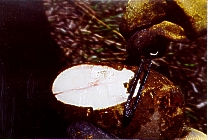Bruise Prevention
As harvest approaches potato bruise prevention is a hot topic. Bruises can cause significant losses. These
losses include shrinkage, loss of tubers due to bruises so they aren't sellable and increased problems with tuber
diseases that enter though skinning or bruises such as early blight and fusarium dry rot. Bruising does not begin
or end with the harvester, there are many factors before and after harvest that can reduce or increase potato
bruising.
Some of the factors before harvest include:
- Good tuber maturity and skin set in paramount in harvesting bruise free potatoes. A good vine kill and
allowing tubers to set skin long enough and not too much late nitrogen affect tuber maturity. These factors
vary a lot with variety.
- Good plant potassium levels has been shown to reduce bruising.
- Clods are a problem in potato harvest because things designed to get rid of colds can bruise potatoes
(Shakers and rollers). Clods are usually formed early in the growing season.
- Field moisture is important so soil falls away from tubers as desired. You want a 20-40% deficit in the hill so
soil stays on primary and colds are soft. If the field is too dry you should irrigate 2-5 days before you harvest.
The two main types of bruises and factors that increase their incidence are:
| Shatter Bruise |
Blackspot Bruise |
| Immature tubers |
Over mature tubers |
| Hydrated tubers |
Dehydrated tubers |
| Low pulp temperatures |
Shows up 1-2 days after bruised |
About 30% of bruising can occur after the harvester so evaluate the entire potato handling process. The
harvester and digger if there is one are the other main source of tuber bruising. The following is a list of things to
look for:
There are many factors to look at to ensure a reduced bruise harvest. Here are some of them:
- Manage nitrates so soil and petiole nitrates drop before harvest for mature tubers.
- Maintain good soil moisture during harvest or a 20-40% deficit. The heavier the soil the more important it is to
have good soil moisture, especially if there are clods.
- Harvest when tubers pulp temperature is 50-65oF. Too cold and shatter bruising rises fast. Too hot and there
is too much harvest heat.
- Harvest when skin is set.
- Keep all drops to 6-8 inches. This can involve smaller rollers and dog leg drive lines, but some older
machines have big drops very hard to fix. A digger with a secondary is much better since drops are usually
less.
- Pad all surfaces. 3/4 - 1" of padding will cushion a 12" drop.
- Adjust chain speeds to keep chains full and avoid pile-ups and rollback. Match chain and ground speed to
avoid bulldozing or not enough dirt and tubers on chains. Secondary chain should be 80% of primary chain
speed. All other chains should be matched at 70 % of primary chain speed.
- Hugger belts help prevent roll back which reduces bruising, but hugger belt speed must be matched to
elevator belt below or hugger belt will skin potatoes.
- Adjust digging blades so tubers flow onto the primary chain and not into the blade. This unseen damage of
tubers being torn by digger blade can be a major source of tuber bruising. The pitch of the digger blade can
greatly affect the easy flow of dirt and tubers up the primary. Many machines have too much pitch to blades.
- Avoid fast changes in tuber pulp temperature. This stresses tubers and can also lead to air checking (a very
deep shatter) in some varieties.
- Only use shakers when necessary.
- Drop deviner chain onto secondary chain to avoid back bouncing and have deviner chain act as flights at first.
- Look for sharp edges and cover them with belts.
- Use belted full width chain if possible. Also use belt deflectors to keep potatoes off chain links and edges of
chains. Maintain these since they wear out.
- Train your operators to minimize drops into the trucks which can be a major source of bruising.
Bruise testing during harvest at various points in your harvest operation is a very useful tool to identify and
prevent tuber bruising. Bruise testing involves soaking tubers in a catecol solution (20 g. catecol in 3 gals.
water) for 1 minute, let them sit for 3 minutes and then peel the tubers. Bruises will show up as red cracks and
marks. The more peels it takes to remove the red, the worse the bruise. Then sort tubers according to bruise
severity: one peel to remove - slight, 2 peels - moderate, 3 or more - severe. Skinning also shows up red before
you peel tubers. Slight and skinned tubers should heal with proper storage with no long term problems though
increased shrink will occur in these tubers and early and late blight infection can occur. Moderate and severe
bruises usually result in grade losses either from the bruise itself or later dry rot infection.

Shatter bruise as it shows up in catecol test
Note: This information should only be used as a guide. Adjustments for local conditions must always be made.
Return to Homepage

